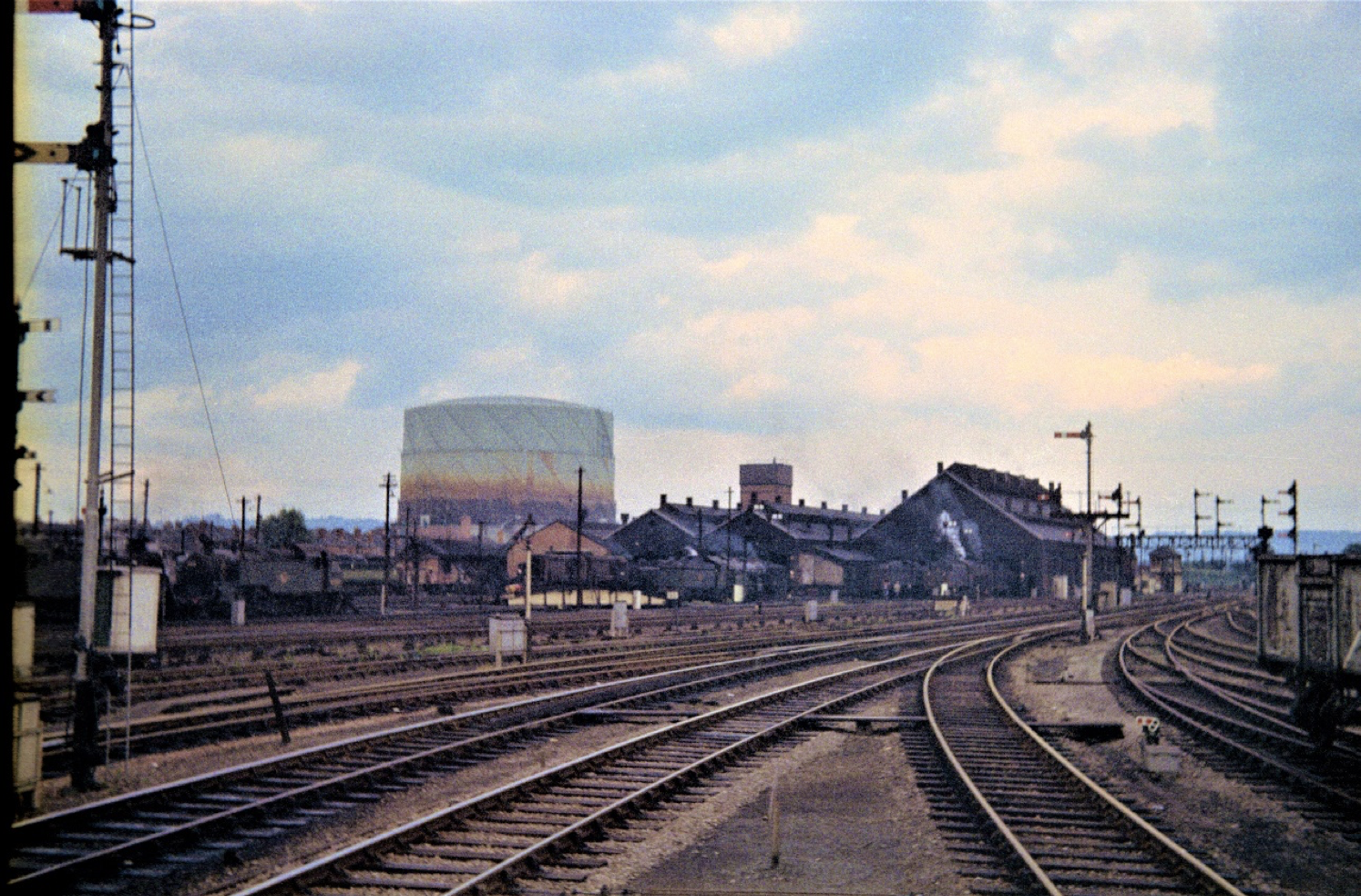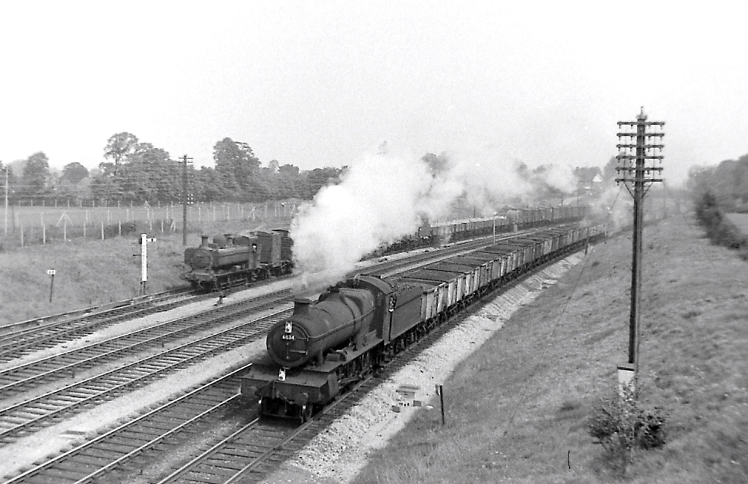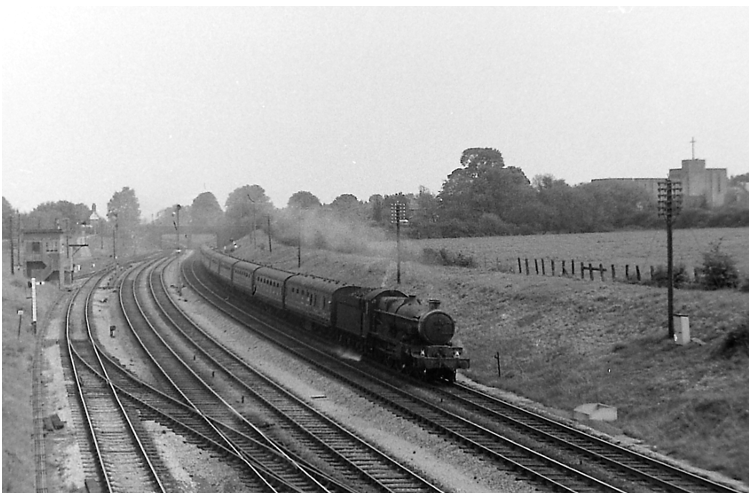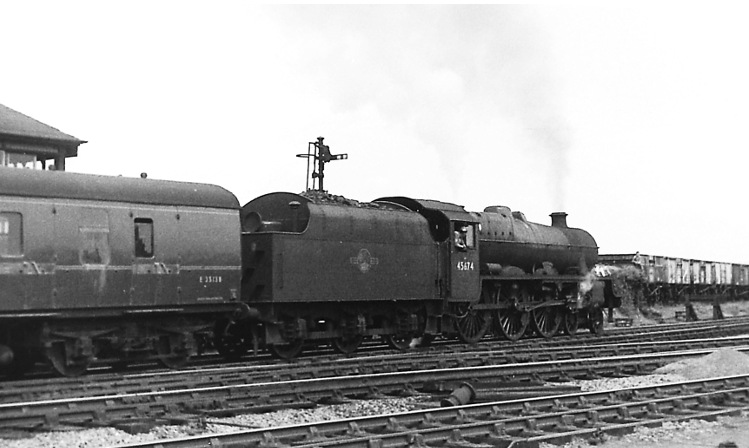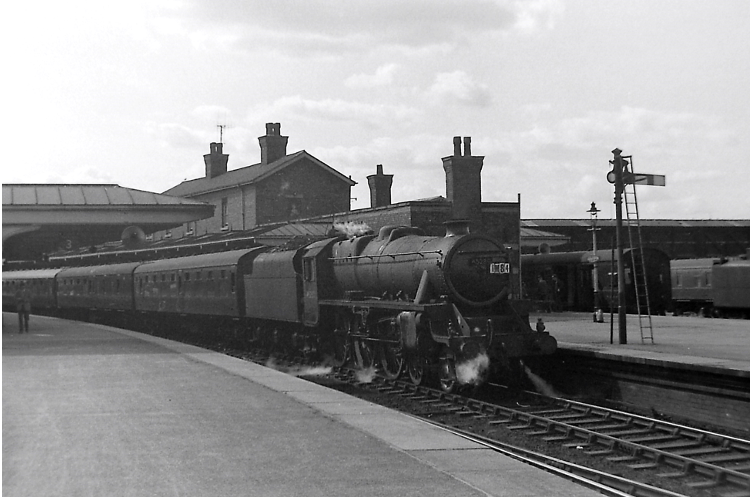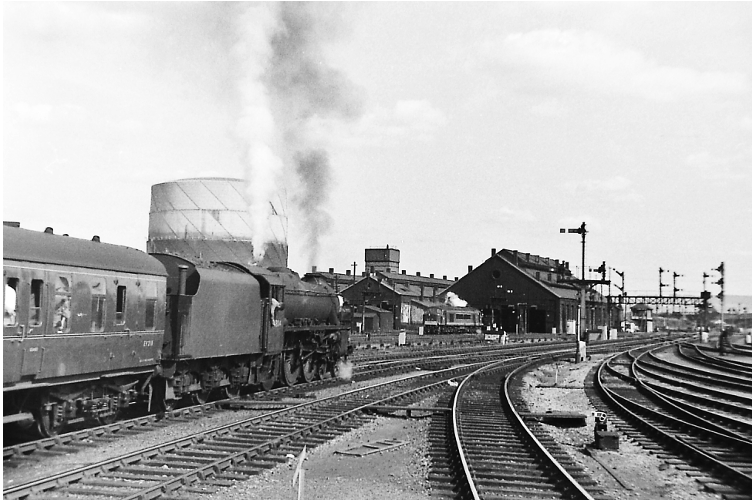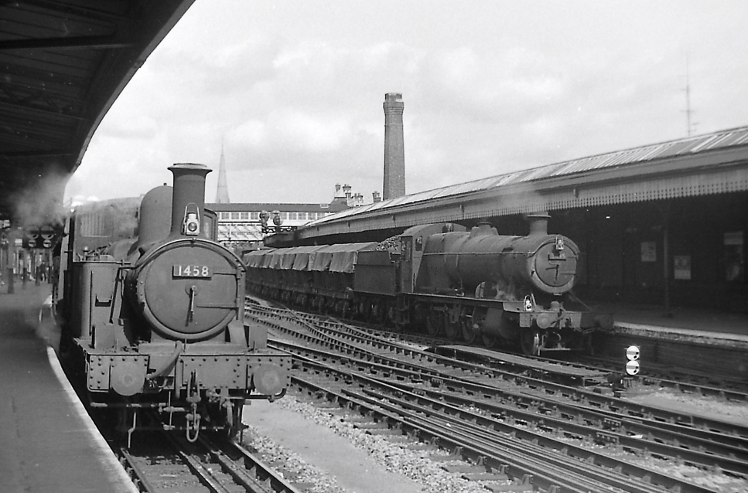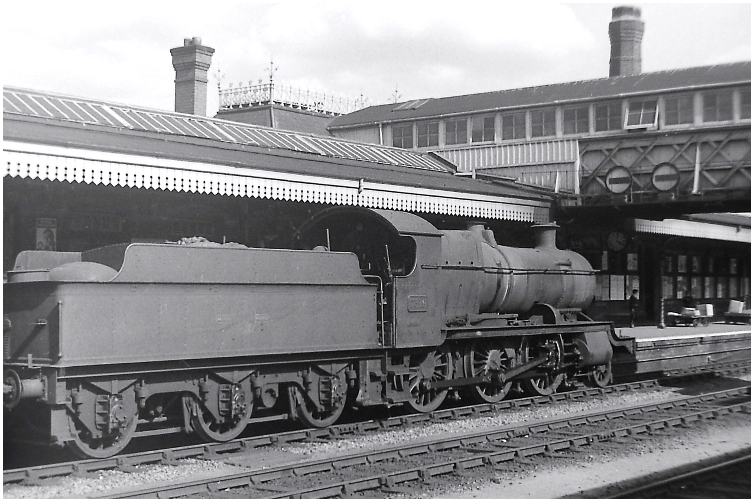1964: Trips home from LONDON
I continued to return home regularly during 1964, but noticed changes in motive power, particularly with the closure of the Midland shed at Barnwood in May, and the transfer of its remaining steam engines to Horton Road MPD. Steam was still in evidence in Gloucester, although the variety of locomotives was not as great. However, GW ‘Halls’, ‘Granges’, Moguls and 2-8-2Ts were still quite regular sights in steam on 85B. In addition, three Standard ‘3’ 2-6-2Ts (Nos. 82036/9/40) made redundant from Exmouth Junction initially and later Taunton were reallocated to 85B about this time and were used on locals and freight trip workings.
A trip home on Easter Monday revealed a line of condemned locomotives awaiting scrapping in Over sidings, whilst unbeknown to me, about this time a collection of ex-GW passenger locos met their end at Sharpness docks.
A scene at Tuffley Junction on 16 May 1964. ‘Grange’ 4-6-0 No. 6834 Dummer Grange heads south on Western tracks with a loaded coal train from the West Midlands. 0-6-0PT No. 9620 waits in the Midland loop for an overtaking express before continuing south with the well-loaded morning trip working to Quedgeley. Note the old Midland Railway starting signal in the loop.
Steam locos were still working many summer Saturday extras. ‘Black 5s’ tended to dominate on most Midland trains, although the occasional ‘Jubilee’ could turn up, especially as Saltley now had an allocation. On the Western lines ‘Castles’ could still be seen on trains from Wolverhampton. One more interesting loco observed on 14 June on a WRS excursion from Bristol to Derby was headed by WC Pacific No. 34079 141 Squadron, an extremely rare visitor to Gloucester: I remember getting up early on that Sunday to photograph the train at the ‘Double Bridges’.
‘Castle’ class 4-6-0 No. 7014 Caerhays Castle powers south through Tuffley Junction on 1V54, the 10.05 am Wolverhampton to Paignton on 16 May 1964. By now steam had been replaced by diesel traction on most express passenger trains in the Gloucester area, apart from holiday extras.
‘Jubilee’ 4-6-0 No. 45674 Duncan (21A) strides confidently across Horton Road level crossing and passes Barnwood Yard with the 11.35 am Paignton to Nottingham on 4 July 1964. Tramway Crossing signal box is behind the first coach.
‘Black 5’ 4-6-0 No. 45280 awaits departure from Gloucester Eastgate with 1N84, the 2.15pm Bristol to York on 22 August 1964. A Standard 5 4-6-0 acts as station pilot whilst the empty stock that will form the 4.30pm Gloucester to Birmingham stopping train rests in the bay platform no. 1.
‘Black 5’ 4-6-0 No. 44804 has steam to spare as it accelerates away from Gloucester Eastgate with the 11.35am Paignton – Nottingham on 22 August 1964. The background, dominated by Gloucester’s gasholder, also shows Horton Road MPD almost devoid of steam apart from a 4500 class 2-6-2T. Barnwood shed had closed in the previous May, hence the presence of a ‘Peak’ class diesel from the Midland route.
On 4 August I went with the family on a seaside excursion to Barry Island, probably for the last time, where scrapped engines were already accumulating in the Docks area. Interestingly, at this time – although I never found out myself until it was too late – Swindon works was also cutting up locomotives from other regions, including a batch of ‘V2s’ from the NER.
Further local service withdrawals
Towards the end of October, I turned my attentions to the Gloucester – Hereford service and the Chalford auto-train service, both of which were about to be withdrawn without replacement, the final day of operation being 31 October 1964. I cycled along the Stroud Valley, photographing the final day, and one surprise was the appearance of a scruffy ‘Castle’, No. 7013 Bristol Castle, on an up freight at Brimscombe. The Hereford branch had been worked by Collett 0-6-0s, large Prairie tanks, and Moguls, although the occasional ‘Manor’ worked the line towards the end, No. 7805 Broome Manor being a regular locomotive.
A scene at Gloucester Central on 4 August 1964. 0-4-2T No. 1458 has just arrived in platform 3 with the 10.00am auto-train from Chalford, whist ‘2800’ class 2-8-0 No. 3835 trundles through the far platform road with a fitted freight of steel coil wagons from South Wales to the West Midlands, an unusual working for steam by this stage. The scene is complemented by the passenger footbridge linking the platforms, the chimney of the hospital laundry, and the spire of St Peter’s RC church.
‘4300’ class 2-6-0 No. 7319 has just arrived at the western end of platforms 4 and 5 at Gloucester Central with the 2.15pm from Hereford on 22 August 1964. Note the banner signal repeaters on the passenger footbridge and the chimney of the hospital laundry in Great Western Road.
The Chalford auto-trains were the last stronghold of the ‘1400’ class 0-4-2Ts and their trailers, one of which, W220W Thrush had worked the Greenford branch previously. Towards the end of the Chalford service it was not unusual to see 0-6-0PTs of ‘5700’ or ‘9400’ classes deputising for a 0-4-2T, which of course meant that push-pull operation of the auto-trains was not possible. Passenger services were also withdrawn on the Berkeley Road – Sharpness branch on 31 October, although through trains to Lydney Town (apart from the school special via Gloucester) had not run since the collapse of the Severn Bridge on 25 October 1960. Local services on the Gloucester – Bristol line did not last much longer, and all local stations were closed from 4 January 1965.
In November 1964 work commenced on a new connection at Standish Junction thus enabling trains from Eastgate station to access the Stroud valley line. This avoided the need for reversal of Cheltenham – Paddington trains at Central station and the requirement for a separate steam loco to work such trains between Cheltenham Spa St James and Gloucester Central.
On the last day of 1964 I took a train to Bristol for the afternoon as steam passenger operation was about to finish with the withdrawal of Midland line local trains on the Bristol – Birmingham line. A poignant sight was a leaking Standard ‘5’ 4-6-0, No. 73030 bringing the empty coaching stock of the 1.40pm to York into platform 12 in the original Brunel train shed, whence the Midland line trains always used to depart.
Further afield, autumn 1964 saw a rationalisation of the Central Wales line. Freight was rerouted away, and Llandovery shed closed; its 2-6-4Ts being transferred to the SR, and its 2-8-0s put into store. At the same time, passenger services were reduced to a single unit running only three times a day between Llanelly and Shrewsbury.
